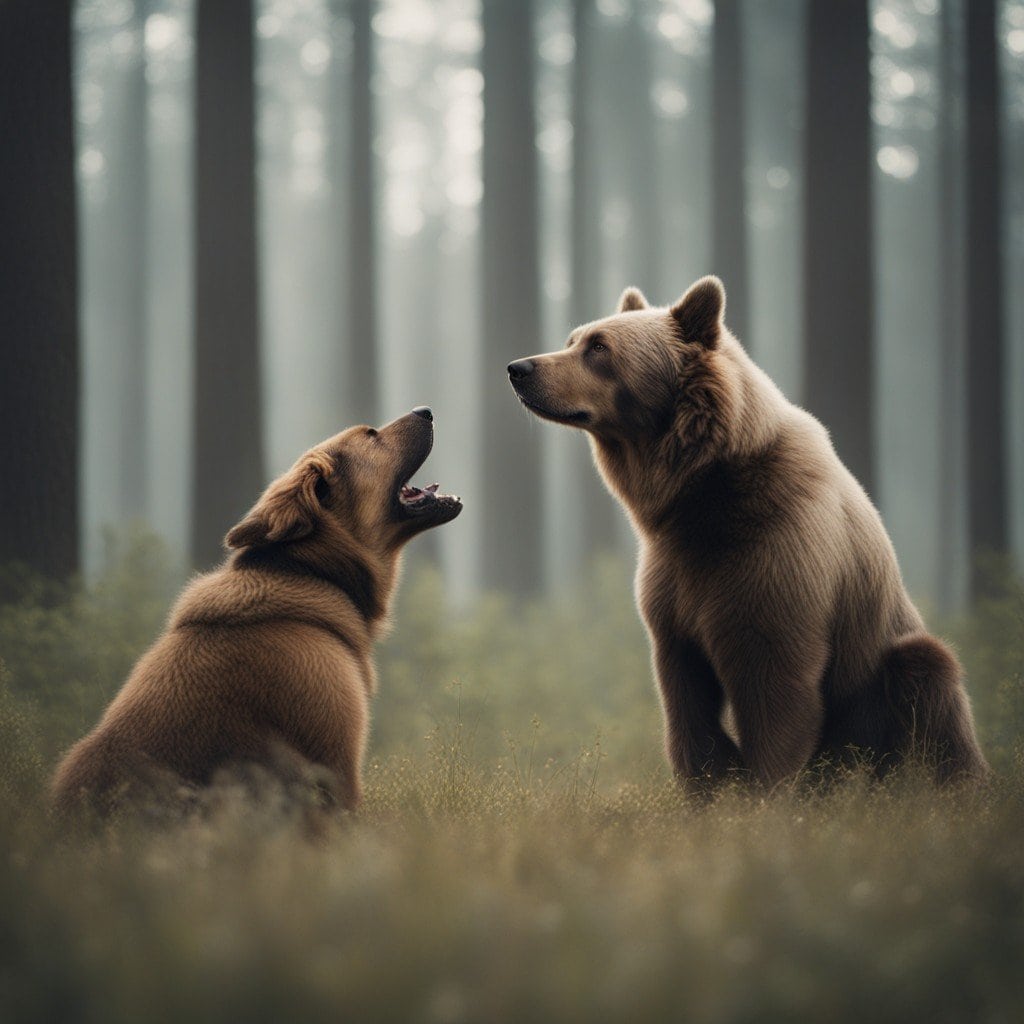Can a Dog Kill a Bear ? Expert Insights Revealed

Dogs are known for loyalty, companionship, and being man’s best friend. But can a dog kill a bear? The dog vs. bear debate has been raging for years, with many people wondering if certain breeds of dogs have what it takes to fend off a bear attack.
We will explore the dynamics of a dog-bear encounter, the history of dogs engaging bears, and the safety measures you should take when your dog encounters a bear. We will also discuss whether certain breeds of dogs can kill a bear and if it is possible for a dog to outrun a bear, with some dogs reaching speeds of up to 45 miles per hour. Read on as we reveal expert insights into this fascinating debate.
Contents
Can A Dog Kill A Bear?

The question of whether a dog can kill a bear is not a simple one to answer. While some larger and more aggressive breeds may have the strength and instinct to take on a bear, it is crucial to remember that bears are powerful and formidable creatures.
In cases where dogs have engaged bears, the outcomes have varied. Some dogs have managed to hold their ground and deter the grizzly bears from attacking, while others have unfortunately been injured or killed. While bears are capable of seriously harming or killing dogs, they are not good climbers and are more likely to run up a tree to avoid an encounter. It is crucial to understand that grizzly bears possess immense strength, sharp claws, and powerful jaws that can seriously harm any adversary.
Nevertheless, certain breeds with protective instincts and a strong prey drive might have a fighting chance against a bear. Breeds such as the Caucasian Shepherd, Kangal, and Tibetan Mastiff are known for their protective nature and ability to confront threats.
However, it is important to note that even these breeds would face an uphill battle against a full-grown bear. A bear’s size, strength, and natural weapons make it an incredibly formidable opponent for any dog.
However, I advocate for responsible and ethical behavior towards animals. Encouraging any behavior that could put a dog in harm’s way, especially when pitted against a bear, is highly discouraged.
Bears are powerful and wild animals that should be respected from a safe distance. It is important to prioritize the safety of humans and animals by avoiding confrontations that could result in harm. Instead, let us focus on promoting harmony and coexistence with nature.
Safety Measures and Encounters
If you live in an area where bears are present or frequent hiking trails known for bear sightings, it is crucial to take safety measures when walking your dog in such environments. Firstly, always keep your dog on a leash to maintain control and prevent them from wandering into potentially dangerous situations.
Secondly, be aware of your surroundings and watch for any signs of bear activity, such as fresh tracks or scat. If you notice these signs, consider altering your route or returning to avoid a potential encounter.
Additionally, it is advisable to carry bear spray when walking in bear country. This can serve as a deterrent if you come face-to-face with a bear or need to protect yourself and your dog.
Furthermore, make sure your dog is well-trained and responsive to your commands. Teaching basic obedience commands such as “sit,” “stay,” and “come” can be invaluable in situations where you need to keep your dog under control or call them back to you quickly.
What to do if you encounter a bear while walking your dog
If you do encounter a bear while walking your dog, it is important to remain calm and avoid any sudden movements. Keep your dog close to you and avoid letting them approach the bear, as this could provoke an attack.
If the bear approaches or shows signs of aggression, try to make yourself look as big as possible by raising your arms and making loud noises. Back away slowly and avoid direct eye contact with the bear. Do not run, as this may trigger the bear’s chase instinct.
It is essential to remember that while dogs can be protective, they are no match for a bear in size and strength. A dog’s instincts may lead them to confront or even attack a bear, but it is unlikely that they can overpower or kill one.
Bears are incredibly powerful animals and have evolved over centuries to survive in their environments. They are equipped with sharp claws and strong jaws, making them formidable adversaries. Even the largest and strongest of dogs would be at a significant disadvantage against a bear.
In the wild, bears are known to defend themselves and their territories when they feel threatened. If a dog were to approach a bear, the bear would likely respond with aggression to protect itself.
Breeds with Potential to Face a Bear
While it is not recommended or advisable to purposely expose your dog to a bear, certain breeds may have a better chance of standing their ground in the face of danger. These breeds typically have a strong prey drive and protective instincts, which could potentially deter a bear from attacking.
Factors such as breed standards, size, strength, and fearless nature all contribute to determining a dog’s potential to face bears. Expert insights are invaluable in identifying dog breeds with the characteristics necessary for bear encounters.
These breeds may be more alert and prepared to face the challenges of encountering bears due to their innate abilities and training. Some breeds that may have the potential to face a bear include:
1. Caucasian Shepherd Dog: This large and fearless breed was originally bred to protect livestock from predators. Their imposing size and ferocious nature make them a formidable opponent for any intruder, including bears.
2. Tibetan Mastiff: Known for their territorial instincts and protective nature, Tibetan Mastiffs are known to be courageous when faced with danger. Their size and strength can make them a force to be reckoned with in the presence of a bear.
3. Karelian Bear Dog: Karelian bear dog, called Karjalankarhukoira in the breed’s native Finland, known for its hunting ability. These dogs are specifically trained to hunt big game, including bears, as well as small-to-large game. They are strong, fearless, and extremely loyal to their owners. As the name suggests, this breed was specifically bred to hunt bears and other big game, making them capable of facing aggressive game. They have a strong prey drive and are adept at tracking and confronting bears, as well as a variety of animals.
It is crucial to prioritize safety and avoid situations where your dog could potentially come into contact with a bear. Suppose you live in an area where bears are present, such as black bears. In that case, it is recommended to take precautions such as keeping your dog on a leash, avoiding areas known for bear activity, and making noise while hiking to alert bears of your presence to avoid a bear encounter in the first place.
Historical Instances of Dogs Engaging Bears
Throughout history, there have been documented cases of dogs engaging bears, showcasing their hunting, protecting, or aggressive nature.
Historical records, anecdotes, and stories reveal the fearless nature, agility, and quick reflexes of dogs when confronting bears. Dogs have been actively involved in bear baiting, bear hunting, and bear control, emphasizing their historical connection with bears.
Instances of dogs standing their ground, protecting cubs, or assisting humans in bear encounters further demonstrate their bravery.
Expert insights on historical dog-bear interactions provide valuable context to understand the behavior of dogs towards bears. These instances highlight the inherent instincts and abilities of certain breeds of dogs when dealing with bears. By looking at these historical instances, we can gain a deeper understanding of the dynamics between dogs and bears.
Are Bears Naturally Intimidated by Dogs?
While it is true that bears are generally larger and stronger than dogs, it is interesting to note that some bears may be naturally intimidated by dogs. Bears are known to have a hierarchical social structure, and encounters with dogs can disrupt their sense of dominance and territory.
Dogs, especially those trained for bear control or protection, can exhibit behaviors that make them appear more formidable to bears. Their barking, growling, and aggressive posturing can be enough to deter a bear from approaching or engaging in a conflict.
Can Certain Dog Breeds Kill a Bear?
While it is rare for a dog to kill a fully grown bear successfully, there have been instances where certain breeds have shown the capability to hold their own against bears, such as the mountain dog. Larger and more powerful breeds like the Tibetan Mastiff, Caucasian Shepherd, and Alaskan Malamute possess the physical strength and protective instincts that make them formidable bear opponents, including wolf dogs, with some weighing up to 68 kg.
These breeds were historically used for bear hunting or guarding livestock in regions where bears were prevalent. Their size, strength, and courage allowed them to confront bears and either drive them away or hold them at bay until human assistance arrived.
Conclusion
So as per your query, can a dog kill a bear? It is uncommon for a dog to kill a fully grown bear. Certain breeds possess the physical abilities and protective instincts to hold their own against these formidable creatures. Dogs trained for bear control or protection can intimidate bears with their behaviors and deter them from conflicts.






